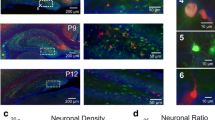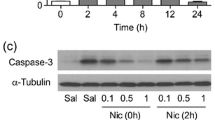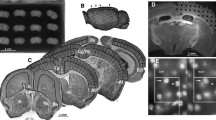Abstract
It has been known for three decades that ethanol, the most widely abused drug in the world, has deleterious effects on the developing human brain, but progress has been slow in developing animal models for studying this problem, and the underlying mechanisms have remained elusive. Recently, we have shown that during the synaptogenesis period, also known as the brain growth spurt period, ethanol has the potential to trigger massive neuronal suicide in the in vivo mammalian brain. The brain growth spurt period in humans spans the last trimester of pregnancy and first several years after birth. The NMDA antagonist and GABAmimetic properties of ethanol may be responsible for its apoptogenic action, in that other drugs with either NMDA antagonist or GABAmimetic actions also trigger apoptotic neurodegeneration in the developing brain. Our findings provide a likely explanation for the reduced brain mass and neurobehavioral disturbances associated with the human fetal alcohol syndrome. Furthermore, since NMDA antagonist and GABAmimetic drugs are sometimes abused by pregnant women and also are used as anticonvulsants, sedatives or anesthetics in pediatric medicine, our findings raise several complex drug safety issues. In addition, the observation that ethanol and several other drugs trigger massive neuronal apoptosis in the developing brain provides an unprecedented opportunity to study both neuropathological aspects and molecular mechanisms of apoptotic neurodegeneration in the in vivo mammalian brain.
Similar content being viewed by others
References
Jones KL, Smith DW. Recognition of the fetal alcohol syndrome in early infancy. Lancet1973; ii: 999–1001.
Jones KL, Smith DW, Ulleland CN, Streissguth AP. Pattern of malformation in offspring of chronic alcoholic mothers. Lancet1973; i:1267–1271
Swayze VW II, Johnson VP, Hanson JW, et al. Magnetic resonance imaging of brain anomalies in fetal alcohol syndrome. Pediatrics1997;99:232–240
Clarren SK, Alvord AC, Sumi SM, Streissguth AP, SmithDW. Brain malformations related to prenatal exposure to ethanol. J Pediatr1978;92:64–67
Kerns KA, Don A, Mateer CA, StreissguthAP. Implementation for a compensatory memory system in a school age child with severe memory impairment. J Learn Disab1977;30:685–693
Sulik KK, Johnston MC, Webb MA. Fetal alcohol syndrome: Embryogenesis in a mouse model. Science1981;214:936–938
Eckardt MJ, File SE, Gessa GL, et al. Effects of moderate alcohol consumption on the central nervous system. Alcohol Clin Exp Res1998;22: 998–1040.
Faingold CL, N'Gouemo P, Riaz A. Ethanol and neurotransmitter interactions-from molecular to integrative effects. Prog Neurobiol1998;55:509–535
Famy C, Streissguth AP, Unis AS. Mental illness in adults with fetal alcohol syndrome or fetal alcohol effects. Am J Psych1998; 155:552–554
Sapp DW, Ye HH. Ethanol-GABA(A) receptor interactions: A comparison between cell lines and cerebellar Purkinje cells. J Pharmacol Exp Ther1998;284:768–776
Bauer-Moffet C, Altman J. The effect of ethanol chronically administered to preweanling rats on cerebellar development: A morphological study. Brain Res1977;119:249–268
Samson HH. Initiation of ethanol reinforcement using a sucrose-substitution procedure in food-and water-sated rats. Alcohol Clin Exp Res1986;10:436–442
Bonthius DJ, West JR. Alcohol-induced neuronal loss in developing rats; Increased brain damage with binge exposure. Alc Clin Exp Res1990;14:107–118
Pierce DR, West JR. Severity of alcohol-induced deficits in rats during the third trimester equivalent is determined by the pattern of exposure. Alcohol1987; Suppl1:461–465
Dobbing J, Sands J. The brain growth spurt in various mammalian species. Early Hum Dev1979;3:79–84
Ishimaru MJ, Ikonomidou C, Tenkova TI, et al. Distinguishing excitotoxic from apoptotic neurodegeneration in the developing rat brain. J Comp Neurol1999;408:461–476
Charriaut-Marlangue C, Ben-Ari Y. A cautionary note on the use of the TUNEL stain to determine apoptosis. Neuroreport1995;7:61–64
Grasl-Kraupp B, Ruttkay-Nedecky B, Koudelka H, Bukowska K, Bursch W, Schulte-Hermann, R. In situ detection of fragmentedDNA( TUNELassay) fails to discriminate among apoptosis, necrosis, and autolytic cell death: A cautionary note. Hepatology 1995;21:1465–1468
Gwag BJ, Koh JY, Demaro JA, Ying HS, Jacquin M, Choi DW. Slowly triggered excitotoxicity occurs by necrosis in cortical cultures. Neuroscience1997;77:393–401
Collins RJ, Harmon BV, Gob´e GC, Kerr JFR. Internucleosomal DNA cleavage should not be the sole criterion for identifying apoptosis. Int J Radiat Biol1992;61:451–453
Kerr JFR, Wyllie AH, Currie AR. Apoptosis: A basic biological phenomenon with wideranging implications in tissue kinetics. British J Cancer1972;26:239–257
Ikonomidou C, Qin Y, Labruyere J, Kirby C, Olney JW. Prevention of trauma-induced neurodegeneration in infant rat brain. Pediatr Res1996;39:1020–1027
Pohl D, Bittigau P, Ishimaru MJ, et al. Apoptotic cell death triggered by head injury in infant rats is potentiated byNMDA antagonists. Proc Nat Acad Sci1999;96:2508–2513
Bittigau P, Pohl D, Sifringer M, et al. Modeling pediatric head trauma: Mechanisms of degeneration, potential strategies for neuroprotection. Restor Neurol Neurosci1998;13:11–23
Ikonomidou C, Bosch F, Miksa M, et al. Blockade of glutamate receptors triggers apoptotic neurodegeneration in the developing brain. Science1999;283:70–74
Ikonomidou C, Bittigau P, Ishimaru MJ, et al. Ethanol-induced apoptotic neurodegeneration, the fetal alcohol syndrome. Science2000;287:1056–1060
Hoffman PL, Rabe CS, Moses F, Tabakoff B.TIN-Methyl-Daspartate receptors and ethanol: Inhibition of calcium flux and cyclic GMP production. J Neurochem1989;52:1937–1940
Lovinger DM, White G, Weight FF. Ethanol inhibits NMDA-activated ion current in hippocampal neurons. Science1989;243:1721–1724
Harris RA, Proctor WR, McQuilkin SJ, et alEthanol increases GABAA responses in cells stably transfected with receptor subunits. Alcohol Clin Exp Res1995;19:226–232
Olney JW, Wozniak DF, Price MT, Tenkova T, Dikranian K, Ikonomidou C. Ethanol induces widespread apoptotic neurodegeneration in the infant mouse brain. Soc Neurosci Abst1999; 25: 550.
Sloviter RS, Dean, E, Neubort S. An electron microscopic analysis of adrenalectomy-induced hippocampal granule cell degenerationin the rat; apoptosis in the adult central nervous system. J Comp Neurol1993;330:337–351
Olney JW, Labruyere, Price MT. Pathological changes induced in cerebrocortical neurons by phencyclidine and related drugs. Science1989;244:1360–1362
Olney JW, Labruyere J, Wang G, Wozniakb DF, Price MT, Sesma MA. NMDA antagonist neurotoxicity: Mechanism, prevention. Science1991;254:1515–1518
Ellison G. Competitive and non-competitive NMDA antagonists induce similar limbic degeneration. NeuroReport1994;5: 2688–2692.
Fix AS, Long GG, Wozniak DF, Olney JW. Pathomorphologic effects of TIN-methyl-D-aspartate antagonists in the rat posterior cingulate/retrosplenial cerebral cortex. Drug Dev Res1994;24: 147–152.
Corso TD, Sesma MA, Tenkova TI, et alMultifocal brain damage induced by phencyclidine is augmented by pilocarpine. Brain Res1997;752: 1–14.
Horvath Z, Czopf J, Buzsaki G. MK-801-induced neuronal damage in rats. Brain Res1997;753:181–195
Wozniak DF, Dikranian K, Ishimaru M, et alDisseminated corticolimbic neuronal degeneration induced in rat brain by MK801. Neurobiol Dis1999;5:305–322
Farber NB, Wozniak DF, Price MT, et al. Age-specific neurotoxicity in the rat associated with NMDA receptor blockade: Potential relevance to schizophrenia? Biol Psychiatry1995;38: 788–796.
Ishimaru M, Fukamauchi F, Olney JW. Halothane prevents MK801 neurotoxicity in the rat cingulate cortex. Neurosci Lett1995;193:1–4
Jevtovic-Todorovic V, Kirby CO, Olney JW. Isoflurane and propofol block neurotoxicity caused by MK801 in the rat posterior cingulate/retrosplenial cortex. J Cereb Blood Flow Metab1997;17:168–174
Jevtovic-Todorovic V, Olney JW, Farber NB. Lamotrigine prevents NMDA antagonist neurotoxicity. Soc Neurosci Abst1998; 24: 745.
Kim SH, Price MT, Olney JW, Farber NB. Excessive cerebrocortical release of acetylcholine induced byNMDAantagonists is reduced by gabaergic and ®-2adrenergic agonists. Mol Psychiatry1999;4:344–352
Farber NB, Price MT, Ikonomidou C, Olney JW. Action of ethanol at GABAA receptors blocks neurotoxicity in the adult brain, but augments neurotoxicity in the developing brain. Soc Neurosci Abst1999;25: 551.
Zahn CA, Morrell MJ, Collins SD, Labiner DM, Yerby MS. Management issues for women with epilepsy. Neurology1998;51:949–956.
Dessens AB, Cohen-Kettenis PT, Mellenbergh GJ, Koppe JG, van de Poll NE, Boer K. Association of prenatal phenobarbital and phenytoin exposure with small head size and with learning problems. Acta Paediatr2000;89:533–541
Jevtovic-Todorovic V, Todorovic SM, Mennerick S, et al. Nitrous oxide (laughing gas) is an NMDA antagonist, neuroprotectant and neurotoxin. Nature Medicine1998;4: 460–463.
DeOlmos JS, Ingram, WR. An improved cupric-silver method for impregnation of axonal and terminal degeneration. Brain Res1971;33:523–529
Author information
Authors and Affiliations
Rights and permissions
About this article
Cite this article
Olney, J.W., Ishimaru, M.J., Bittigau, P. et al. Ethanol-induced apoptotic neurodegeneration in the developing brain. Apoptosis 5, 515–521 (2000). https://doi.org/10.1023/A:1009685428847
Issue Date:
DOI: https://doi.org/10.1023/A:1009685428847




